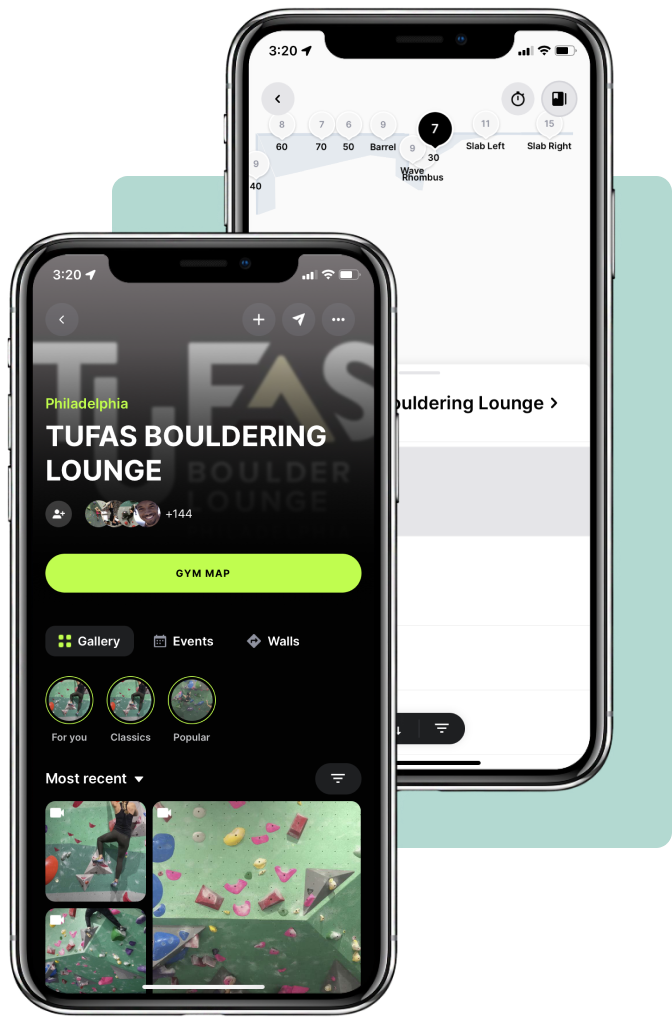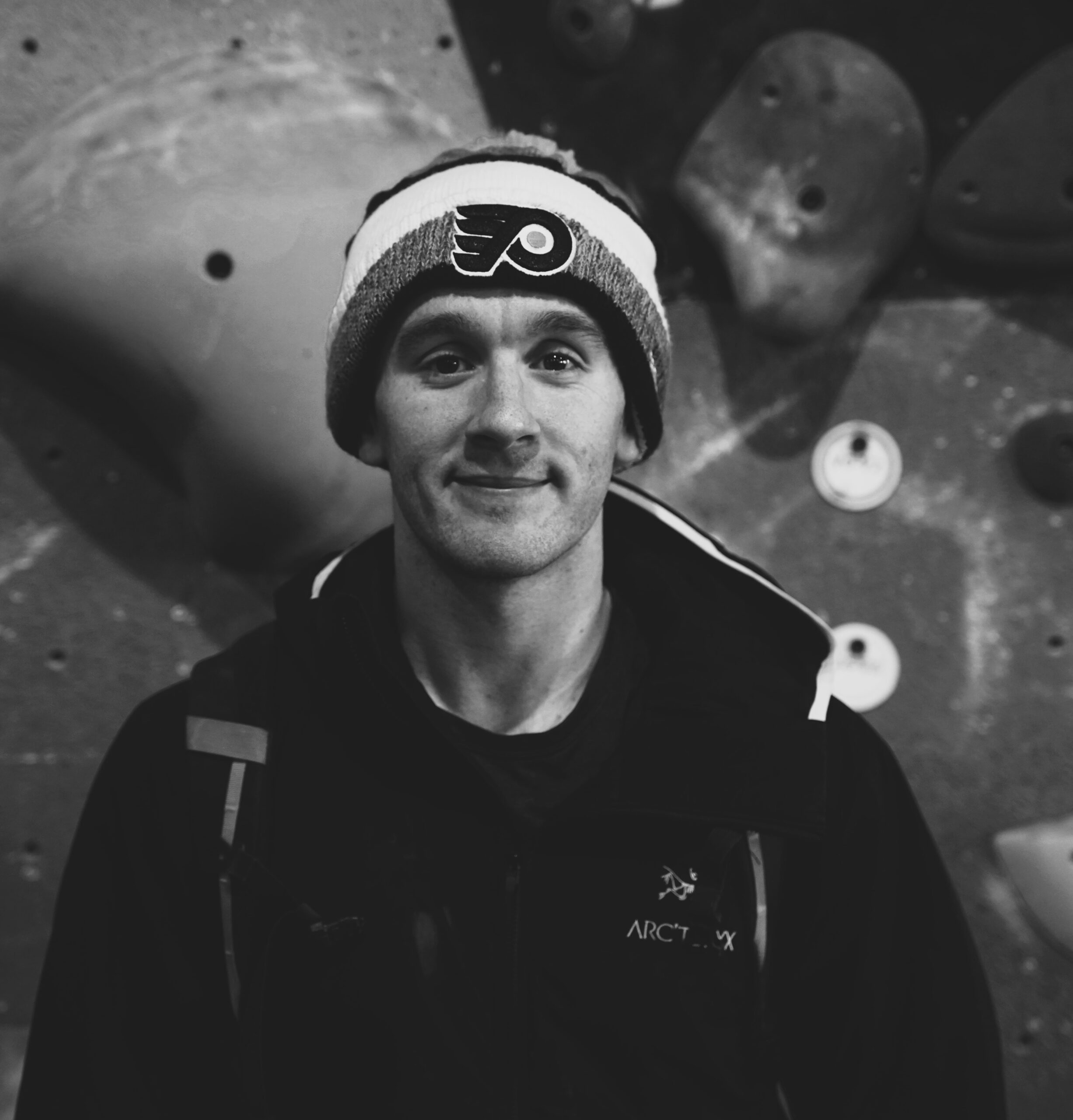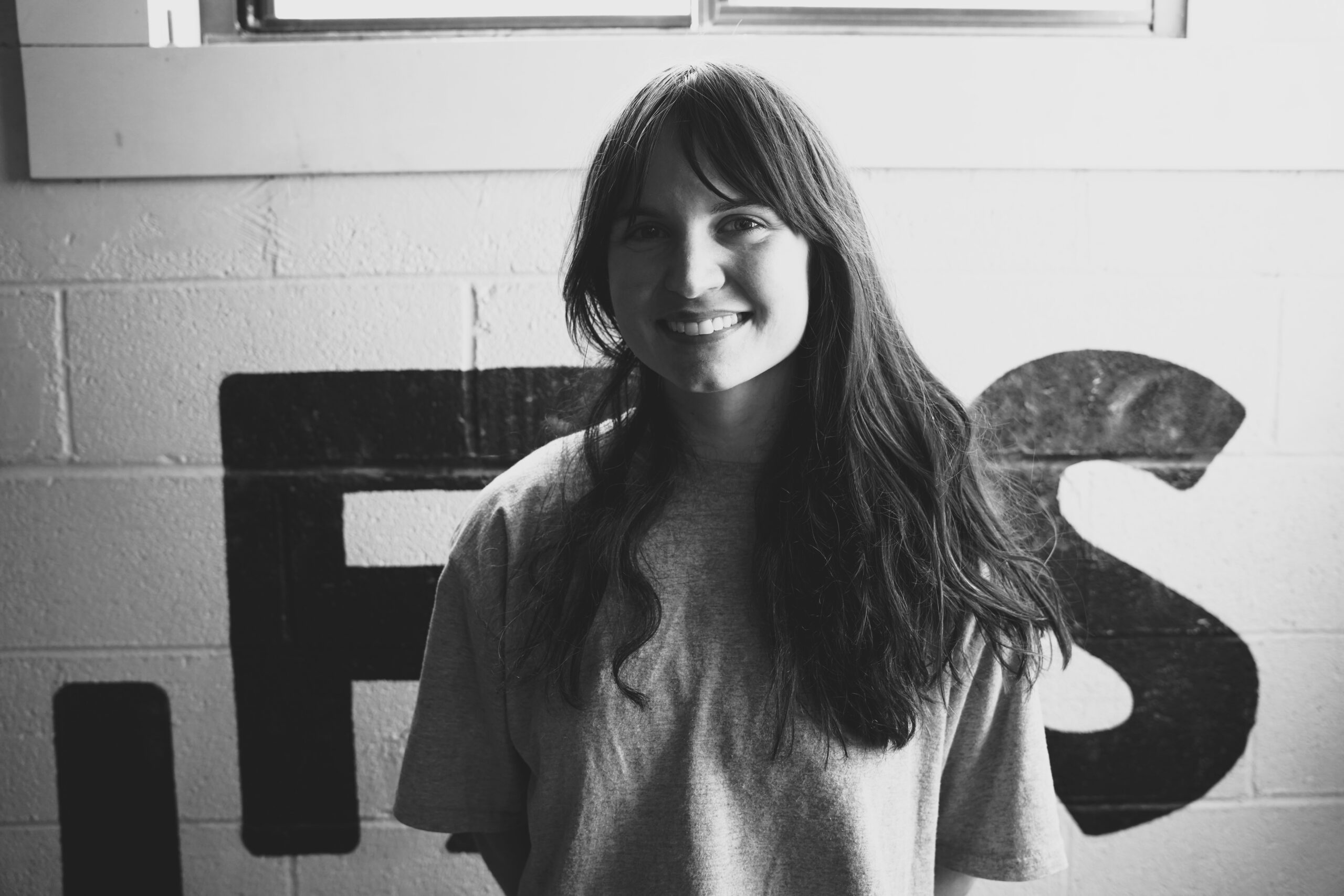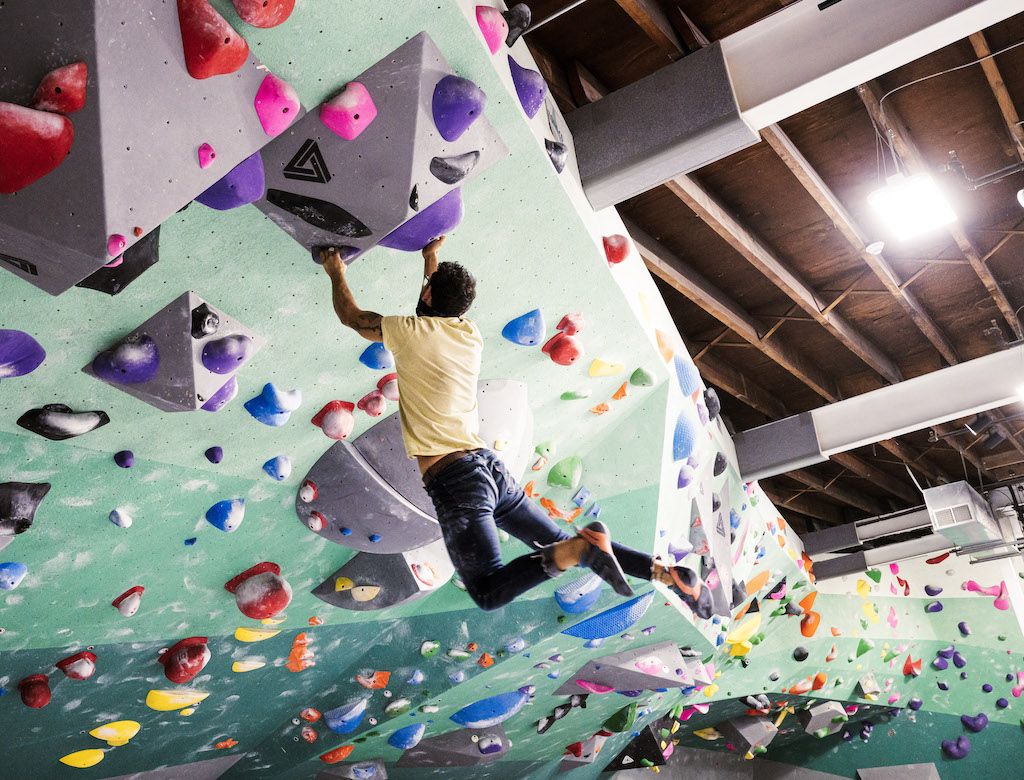
Routesetting
Setting Philosophy
At Tufas Boulder Lounge we aim to provide our community with a diverse selection of high quality boulder problems that showcase the many different styles of climbing movement
Styles
We have 4 main styles that we use to categorize our boulder problems to guarantee an equal distribution of each within any given circuit. While many climbs may exhibit multiple styles there will always be an intentional learning component to each climb.
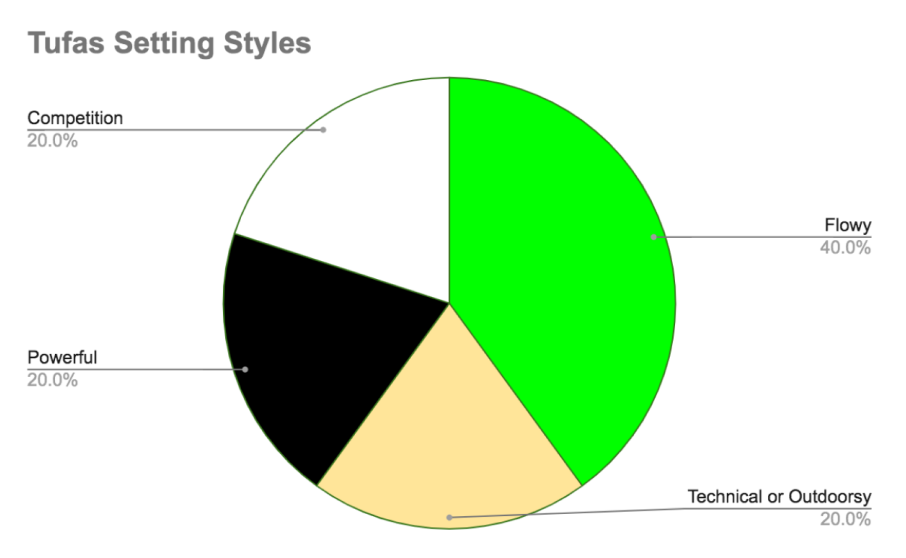
Flowy, technical, power, competition
Flowy
These are the boulders you most likely climb every visit as warm ups or as endurance trainers. They are not overly technical or cruxy. They are designed to be comfortable, flowy and very repeatable.
Powerful
Power is defined as the ability to exert a maximal force in as short a time as possible. So by definition these climbs will require quick bursts of trying hard. That doesn’t mean that all powerful climbs will be filled with big moves that require jumping. Small moves can be powerful too.
Technical
Generally speaking you can expect a technical climb to have delicate moves that require balance, precise footwork and nuanced body positions. Many of the technical climbs we set in the gym could be labeled “outdoorsy” resembling certain features and characteristics commonly found in outdoor climbing.
Competition
Our competition problems aim to focus on a specific skill and movement style generally not found in “commercial” routesetting due to the intensity, complexity and level of commitment required. Competition climbs are generally not repeated as often as the other styles, but even if they are only climbed once the enjoyment of figuring them out makes them a valuable part of our offerings.
Understanding Circuits
At Tufas Boulder Lounge we use a circuit grading system to help curate climbing experiences. Each Circuit will have a variety of different styles of movement to enjoy and skills to teach you.
It is best to think of each circuit as an overall experience rather than just the difficulty of a climb due to the fact that there are many different elements that can make a climb more or less “difficult”. Some elements may be harder or easier for different people depending on a lot of different factors such as body size, body type, finger strength, flexibility, mobility, ability to decode complex sequences etc etc etc
The V Grade helps guide us but doesn’t define the experience. Two climbs may have the same “grade” but completely different requirements and therefore can be designated to different circuits for different audiences and experiences.
Remember grades and difficulty are subjective. Having fun and growing as climbers and as individuals is the goal. We hope you find joy and fulfillment while discovering what each circuit has to offer you.
To be better understand how all these different elements are combined and calibrated continue on to Understanding RIC
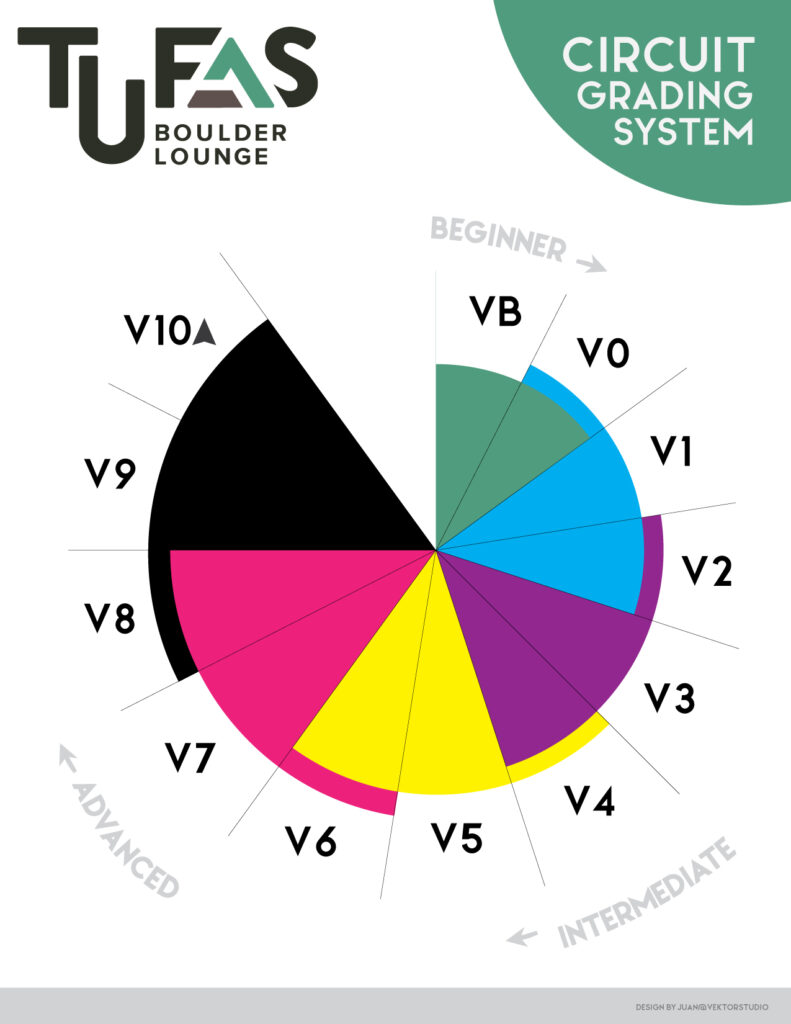
Green Circuit VB-V0
The Green Circuit Is intended for new climbers and each climb is designed to be very accessible. The goal is to provide fun interesting movement that is accessible to anyone who walks through the doors wanting to try climbing.
- Large comfortable handholds and footholds
- Balanced body positions
- Lower finish holds
- Slab to slightly overhanging terrain
Once climbers have completed all the Green Circuit climbs they can start to build skills and challenge themselves in the Blue Circuit.
Blue Circuit V0-V2
The Blue Circuit is a curated experience for new and experienced climbers looking to gain new skills.You will generally experience only one of the following elements in each blue circuit climb.
- Powerful and dynamic movement (on good holds)
- Technical movements and body positions
- Smaller handholds and footholds
- Complex and/or Sequential movement
Elements are combined and intertwined more as you move into the purple circuit.
Purple Circuit V2-V4
The purple circuit is intended for climbers who have completed most of the blue circuit climbs and are ready to start putting their newly acquired skills into practice. Each purple circuit climb will generally try to combine no more than two of the following elements. Some purple circuit climbs will only contain one of the following elements. In such instances the one element will generally be dialed up in Risk, Intensity or Complexity
- Powerful and dynamic movement ( on good and… not so good holds)
- Complex and/or sequential movement
- Body tension and core strength required for performing moves or holding positions
- Smaller hand holds and foot holds
- More finger strength in order to hold onto smaller holds, pinches or slopers
Powerful movements to small holds that also require more body tension with complex movements/sequences are found in Yellow Circuit and above.
Yellow Circuit V4-V6
Yellow Circuit climbs begin to require all of the following elements to a moderate degree, but will sometimes focus only on one or two of the elements dialed way up in Risk Intensity or Complexity.
- Powerful and dynamic movement ( on good and… not so good holds)
- Complex and/or sequential movement
- Body tension and core strength required for performing moves or holding positions
- Much smaller hand holds and foot holds
- More finger strength in order to hold onto smaller holds, pinches or slopers
- Coordinated movements
- Power Endurance
Pink Circuit V6-V8
Pink Circuit climbs will generally have 2-3 elements dialed up along with 1-2 elements dialed WAY up.
- Powerful and dynamic movement ( on good and… not so good holds)
- Complex and/or sequential movement
- Body tension and core strength required for performing moves or holding positions
- Much smaller hand holds and foot holds
- More finger strength in order to hold onto smaller holds, pinches or slopers
- Coordinated movements
- Power Endurance
Black Circuit V8-V10+
Black Circuit climbs will generally combine many and sometimes all of the following elements dialed WAY up. The black circuit also has the biggest collection of V grades ranging from V8+ up to V13+. There are more V8s and V9’s than V10’s and V11’s but the jump from V8-V11 is quite dramatic. Not all Black Circuit climbs will be accessible to the black circuit audience.
- Powerful and dynamic movement ( on good and… not so good holds)
- Complex and/or sequential movement
- Body tension and core strength required for performing moves or holding positions
- Much smaller hand holds and foot holds
- More finger strength in order to hold onto smaller holds, pinches or slopers
- Coordinated movements
- Power Endurance
Understanding RIC- Risk, Intensity and Complexity
RIC is a scale used in the creation of routes/boulders for competition and commercial routesetting to help dial in a very particular experience for the climbers. While it originated in competition settings it has become an incredibly valuable tool for commercial route setting as well. RIC is a great tool for helping to articulate the different factors that contribute to why certain climbs end up in a particular circuit while others do not.
Risk
Risk does not mean danger in the traditional sense. When we talk about risk it’s NOT how likely someone is to get hurt, it’s rather how likely is it that someone might fall off or “feel” they might fall off. It’s more of an uncertainty factor, committing to a move and breaking through that uncertainty. This is true in indoor and outdoor climbing. High risk is often associated with really small and technical footmoves, maybe a Dyno to a sploper that may or may not be easy to hold, or a balance move that feels impossible until you commit to the movement. Risk is really about commitment amidst uncertainty.
Intensity
Intensity is probably the most recognizable and easiest to define. How hard do you have to crimp, how much core do you need, how much body tension is required, how “hard” do you need to pull. While intensity has traditionally defined what V’ Grade a boulder gets, it often fails to determine what circuit a climb should be in. If the intensity is very high coupled with high risk and high complexity it requires much more of a climber and is often bumped into a harder circuit even though the intensity of the crimps or body tension might be the same as another clim
Complexity
Complexity is fairly straightforward although it can come in many different forms and can be quite deceptive. Some sequences may be cryptic and very difficult to read beforehand while other sequences may seem straightforward but when you’re in the movement it may require very specific balance, foot movements or body positioning that can be difficult to figure out on a first attempt.
View Latest Sets
Looking for our latest routes? Download the Kaya App today and search for “Tufas Boulder Lounge.”
We keep Kaya updated to all of our latest changes so checking there will give you the greatest sense of what the sets and circuits look like right now!
